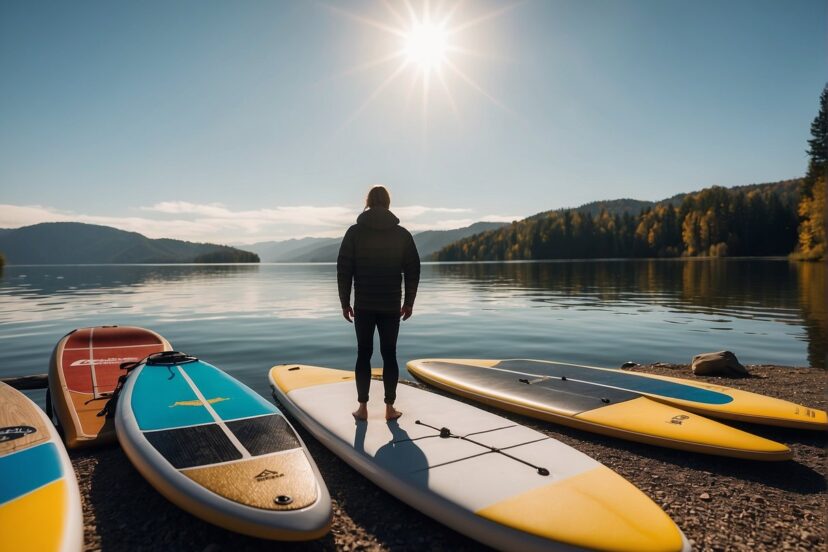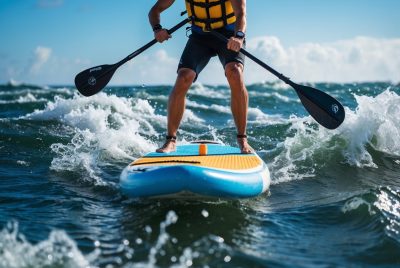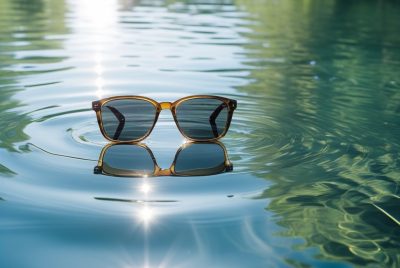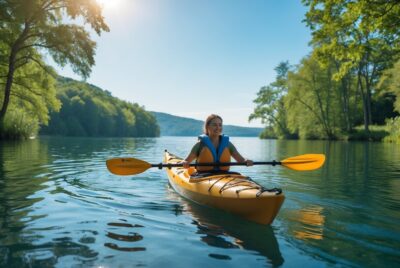What Size Paddle Board Do I Need: Choosing the Perfect Fit
*We may earn a commission for purchases made using our links. Please see our disclosure to learn more.
What Size Paddle Board Do I Need: Choosing the Perfect Fit
Selecting the right size paddle board is crucial for maximizing performance, stability, and enjoyment on the water. I’ve found that factors such as my height, weight, and paddling activities play important roles in determining the size of the paddle board I need. Whether I’m cruising calm lakes or venturing onto choppier seas, finding a board with the correct dimensions will ensure I have the best experience possible.

When considering a paddle board, I assess my skill level and what I’ll be using the board for. As a novice, I might favor a wider board for stability, while as an advanced paddler looking for speed, I’d opt for a narrower option. Board length is also important; longer boards tend to glide better and are great for touring, whereas shorter boards are more maneuverable, making them ideal for surfing or recreational use.
In relation to volume and weight capacity, I pay close attention to ensure that the board can comfortably support my weight along with any gear I plan to bring along. A board with adequate volume and a properly assessed weight limit will keep me afloat and improve my paddling efficiency. Understanding these principles has helped me make informed choices and find a paddle board that suits my needs perfectly.
Understanding Paddle Board Basics

When selecting a paddle board, it’s critical to consider its components, types, and the relationship between hull type and performance. Understanding these fundamentals can guide me to the right board for my activities and skill level.
Components of a Paddle Board
Paddle boards are comprised of a deck, where I stand, and a bottom, which contacts the water. The rails (sides of the board) affect how the board slices through water. Key dimensions include:
- Width: Affects stability. Average boards are between 31″ and 33″ wide.
- Length: Impacts tracking and maneuverability. Common lengths range from 10 to 12 feet.
- Thickness: Influences volume and buoyancy. Many boards have a 6″ thickness for optimal buoyancy.
Materials used, such as epoxy, fiberglass, wood, plastic, or foam, play a vital role in the board’s weight, rigidity, and durability.
Types of Paddle Boards
- Solid SUP Boards: Constructed from materials like foam, wood, plastic, epoxy, and fiberglass. Known for better performance and durability.
- Inflatable SUP Boards: Made from high-grade PVC and offer transport and storage convenience. These have increased in rigidity and performance over the years.
Hull Type and Board Performance
Hull type is a driving factor in board performance:
- Planing Hull: Wide and flat, resembling a surfboard. Great for leisure paddling, offering stability and versatility.
- Displacement Hull: Features a pointed nose or bow. Designed for speed and efficiency, best for touring or racing activities.
By acknowledging the significance of a paddle board’s dimensions, materials, and hull type, I can determine the best board for my size and skill level, balancing stability with performance.
Determining the Right Paddle Board Size

When choosing a paddle board, it’s crucial to consider size, weight capacity, and volume. These factors determine how the board performs on the water. I’ll guide you through these elements to help you decide on the right size for your needs.
Paddle Board Dimensions and Their Impact
Paddle board sizing is defined by three primary dimensions: length, width, and thickness. Each has a direct impact on how the board behaves in the water. A longer board increases speed and tracks straighter, whereas a wider board provides greater stability. The thickness affects the volume and weight capacity, which in turn influences buoyancy.
Weight Capacity and Volume Explained
The weight capacity and volume of a paddle board are intertwined. Typically, a board should be able to support at least the user’s weight plus any gear. The volume, measured in liters, contributes to buoyancy. For example, a board that is 6″ thick with a maximum weight capacity of 280 lbs is designed to keep a user up to 240 lbs well buoyant.
The Importance of Board Length
Paddle board length varies based on the activity. Generally, a length between 304 cm to 335 cm (10 to 11 feet) is versatile for all-around use. If speed is my priority, a length of 10 to 12 ½ feet is efficient. For casual use, such as yoga or fishing where space and stability are more important, opt for a longer board.
How Board Width Affects Stability
Board width is pivotal for stability. New paddlers or those wanting a serene experience might prefer a width of 33″ to 35″. This width is forgiving for balance and ideal for beginners. For more experienced paddlers or those seeking performance, a narrower width, typically 31″ to 33″, can be more suitable as it allows for streamlined movement.
Choosing a Paddle Board Based on Activity

When selecting a paddle board, my choice is heavily influenced by the activity for which I’ll use the board, as each type offers different features suited for specific conditions and uses.
Paddle Boarding for Beginners
For beginners like me, stability is the priority, so I would look for a wider board. An inflatable SUP with a width ranging from 31 to 33 inches is ideal as it provides a good balance between stability and handling.
Paddle Boards for Touring and Racing
When I’m interested in touring and racing, speed becomes a critical factor. I need a board that is long and narrow to cut through water efficiently. An appropriate board for this activity would measure over 12 feet long and slightly narrower to increase glide and speed.
Paddle Boards for Surfing
SUP surfing demands a board that’s maneuverable in waves. Therefore, a shorter and narrower board suits me best. Typically, the size of a surf-specific SUP would be shorter than 10 feet, allowing for sharper turns and better wave handling.
Paddle Boards for Yoga and Fitness
For yoga and fitness activities, I require a board that offers maximum stability and enough space to perform exercises. An ideal choice is a board that’s around 10 to 12 feet in length and wider than average, approximately 34 inches wide, to support my movements and provide a steady platform.
Considerations for Different Water Environments

When choosing a paddle board, the specific water environment where I plan to paddle heavily influences my decision. The board’s design suitable for flat water may not perform well in the ocean, and one that’s optimal for whitewater conditions would likely create too much drag on calm surfaces.
Paddle Boards for Flat Water
For paddling on lakes, bays, and other flat water environments, I prefer a longer and narrower board. These boards are designed to glide through the water with minimal resistance, making for an efficient and smooth experience—ideal for touring, fitness paddling, or long-distance journeys. The weight limit should be considered based on the intended use, whether I’m carrying gear or not.
Paddle Boards for Ocean and Waves
When I venture into the ocean or areas with waves, I need a paddle board with good maneuverability and stability. A shorter and wider board is typically more suitable for handling the ocean’s unpredictability. This design provides the balance I need amid waves and the ability to pivot and carve through the water without creating excessive drag.
Paddle Boards for Whitewater Conditions
Navigating whitewater conditions demands a board that’s highly durable and responsive. I look for a board with rocker—where the nose and tail are slightly raised—to tackle choppy water conditions effectively. A thick, rugged construction is crucial to withstand the impacts. The volume and weight limit are essential here to ensure I stay afloat in the turbulent waters.
Paddle Board Features for Specific User Needs

In choosing the right paddle board, I consider the specific activities it’ll be used for and the unique features that cater to those needs. Whether it’s for kids, fishing, or performance, the right features make a significant difference in the experience.
Paddle Boards for Kids
For children, stability is paramount. I recommend paddle boards that are typically wide and inflatable, providing a stable platform that helps with balance. An ideal size is under 10 feet in length and about 30 inches in width, ensuring the board is maneuverable for a kid’s smaller stature.
- Width: 30 inches for stability
- Length: Under 10 feet for better control
Paddle Boards for Fishing
Fishing requires a board that’s both stable and versatile. A wider board, around 34 inches, grants the stability needed to cast and reel in comfortably. For my fishing adventures, I choose boards that come with additional features like mounts for fishing gear, and they’re often longer to offer more deck space.
- Width: 34 inches or more for stability and space
- Length: 11 to 12 feet to accommodate fishing gear
Paddle Boards for Performance and Maneuverability
When I’m after performance and maneuverability, a narrower and longer board is my go-to. It cuts through the water for increased speed and agility. A length of 12 to 14 feet with a narrow build enhances performance for activities like racing or advanced surf SUP.
- Width: Around 30 inches for enhanced performance
- Length: 12 to 14 feet for better maneuverability and speed
Each feature serves a particular purpose, be it for a child’s playtime or a serious fishing expedition. The ideal paddle board fits the activity, ensuring a secure and enjoyable time on the water.
Inflatable vs. Solid Paddle Boards
When choosing the right paddle board for my needs, I consider two main types: inflatable SUPs and hard paddle boards, each offering distinct advantages in durability, storage, and performance.
Advantages of Inflatable SUPs
Storage and Transport: One of the greatest advantages of inflatable stand-up paddleboards (SUPs) is their convenience in terms of storage and transport. When deflated, they can be stored in small spaces, ideal for those with limited storage at home or in their vehicle.
Durability: I find inflatable SUPs remarkably durable. They are designed with high drop stitch thread count, and a quality inflatable board with at least 14 PSI can withstand considerable use. Plus, they handle accidental drops and impacts better than hard boards.
Pros and Cons of Hard Paddle Boards
Stability and Performance: Hard paddle boards typically offer better stability due to their rigid structure. I notice that they tend to track straighter in water, providing an advantage in speed and maneuverability, which is crucial for performance-focused activities like racing or surfing.
Cost and Weight: Although they usually come with a higher price tag – sometimes up to 100% more than their inflatable counterparts, the solid construction of hard paddle boards justifies the cost for those seeking maximum performance. They do weigh more, which can affect my ease of handling them out of the water.
Selecting a Paddle Board for Your Skill Level
When choosing a stand up paddle board, it’s imperative that my selection aligns with my skill level to ensure I get the most enjoyment and performance out of my paddling experience. As I progress from beginner to expert, different board characteristics will cater to the evolving challenges and abilities I encounter.
Paddling Considerations for Beginners
As a beginner, my primary focus should be on stability and ease of use. Beginner paddle boards are typically wider, in the range of 31 to 33 inches, providing a stable platform which is crucial for gaining balance and confidence. A board length of somewhere between 9’6″ to 11′ is generally suitable for new paddlers like myself, allowing for ample surface area without being too cumbersome to maneuver.
- Width: 31 to 33 inches for stability
- Length: 9’6″ to 11′ for manageability
Paddle Boards for Intermediate Users
Moving to an intermediate level, I can handle a board with less width, around 30 to 32 inches, as my balance and paddling techniques improve. The length could vary between 10’6″ to 12’6″ depending on the activities I plan to use it for, such as touring or fitness paddling. This mid-range size offers a blend of stability and agility, providing me with the opportunity to challenge myself further with quicker turns and increased speed.
- Width: 30 to 32 inches for improved maneuvering
- Length: 10’6″ to 12’6″ for versatility
Challenges for Advanced Paddlers
As an advanced paddler, I look for boards that allow for high performance and precision. Narrower boards, somewhere around 29 inches or less in width, and longer lengths of over 12’6″ enhance speed and tracking. These dimensions are more challenging to balance but are excellent for racing and intense paddling sessions, pushing my skills to the limit.
- Width: 29 inches or less for speed
- Length: 12’6″ or more for better tracking
By carefully considering these specifications relative to my skill level, I ensure that I select a stand up paddle board that not only matches my current abilities but also supports my progression in this exciting sport.
Additional Equipment and Accessories
When discussing paddle boarding, it’s crucial for me to consider not only the board itself but also the additional gear that can enhance the experience and ensure safety. I’ve organized my recommendations into three specific areas to help you prepare for your SUP activities.
Essential Paddle Boarding Gear
For successful outings on the water, the following essential gear should accompany your paddle board:
- Paddle: Ensure it is adjustable to match your height for efficient paddling.
- Leash: A board leash keeps your SUP tethered to you if you fall off.
- SUP Deck Bag: Great for storing essentials like snacks and sunscreen.
Carrying and Storage Solutions
I know how important it is to have convenient ways to transport and store your paddle board:
- Roof Racks: For easy transportation of your SUP on most vehicles.
- Wall Racks: They offer safe and space-efficient storage at home.
- Board Bags: Protect your SUP from the elements when not in use.
Personal Safety Equipment
Safety is paramount in any water sport, and here’s the equipment I consider non-negotiable:
- Personal Flotation Device (PFD): Always wear a properly fitting PFD.
- Waterproof Pouch: Keeps personal items like your phone and keys dry.
- Safety Whistle: For signaling in case of an emergency.
Remember to check the weight capacities of your gear to ensure they’re appropriate for your SUP activities and to secure any extra gear adequately on your board.
Using a Paddle Board Size Chart
A paddle board size chart is a valuable resource for selecting the ideal Stand Up Paddleboard (SUP) for my needs. It helps me factor in my height and weight to determine the correct board size for balance and performance.
How to Read a Size Chart
When I examine a paddle board size chart, I look for recommendations that correlate to my personal measurements. Size charts typically list board lengths and widths next to height and weight ranges. I ensure the chart includes both dimensions because a board that’s too narrow or short for my build can compromise my stability and enjoyment, whereas a board too big can be unwieldy and difficult to control.
Height and Weight Considerations
The specifics of height and weight are crucial:
- Height: A board’s length should generally be 9-10 inches taller than my height.
- Weight: Weight determines the board’s volume and thickness – crucial for buoyancy. The heavier I am, the more volume I need my board to have, ensuring it stays afloat and stable.
For example, if I weigh between 125-150 lbs, a common recommendation is a board that’s approximately 10 feet long and 30-32 inches wide.
Calculating the Correct Board Size
For an accurate calculation, I use the following steps:
- Start with my height and weight.
- Consult a paddle board size calculator or chart that considers my weight range and matches it to board volume (liters) and dimensions.
- Account for my skill level; beginners benefit from wider, longer boards.
- Factor in the primary use; racing boards are narrower and touring boards are longer for efficiency.
Using these guidelines, I can confidently find the size SUP that matches my physique and paddling intentions.
Understanding the Impact of Design and Materials
When selecting the ideal paddle board for my needs, I consider how design and materials significantly influence performance, stability, and usage. Each aspect, from board shape to construction materials, affects how a board interacts with the water and how it performs under various conditions.
Effects of Board Shape
The shape of the paddle board is a key determinant in its performance and suitability for different activities. Boards designed with a planing hull are flatter and wider, making them versatile for leisure paddling and surfing. They offer more stability due to their size and board width, making them a preferred choice for beginners. In sharp contrast, paddle boards with a displacement hull have a pointed nose or front, similar to that of a canoe, which allows them to slice through water efficiently, reducing drag and increasing speed. This design requires more skill as it trades off some stability for speed and is thus better suited for racing or long-distance touring.
Influence of Construction Materials on Performance
My paddle board’s construction material significantly influences its weight, stiffness, and durability, which in turn affects its performance in the water. Traditional solid boards are commonly made from foam cores wrapped in fiberglass and epoxy, providing a balance between weight and durability. Newer materials such as carbon fiber are lighter and increase the rigidity of the board, albeit often at a higher cost.
| Material Type | Weight | Stiffness | Durability | Performance Indicator |
| Foam core wrapped in fiberglass | Moderate | High | High | Versatile, well-rounded performance |
| Carbon fiber | Light | Very High | Moderate | Enhanced speed and responsiveness |
| Plastic | Heavy | Low | Very High | Increased resistance, lower speed |
The weight capacities of these materials differ, with heavier materials often able to support more weight, which is an essential factor for larger surfers or those who carry additional gear.
Hybrid and Specialty Boards
Hybrid boards are a testament to the versatility in paddle board design. They combine features from different board types to suit surfers looking for multi-use options. For instance, a hybrid may have the stability of a planing hull with some speed characteristics of a displacement hull. Specialty boards are similarly adaptive, often being customized for niche activities like fishing or yoga. These designs might include additional width for stability or supplementary weight capacities to accommodate gear. Hybrid and inflatable boards are excellent examples of versatile and convenient designs that cater to a broad range of surfing activities.
Frequently Asked Questions
When selecting a paddle board, my primary considerations are my weight and height, the stability I desire, and my skill level. Let’s explore these details through common queries.
1. How do I determine the appropriate paddle board size for my weight and height?
For my weight and height, I typically select a board with enough volume and width to provide stability and support. A board’s volume, indicated in liters, should be sufficient to float me effectively, and its width should ensure stability.
2. What are the key factors to consider when selecting the right size paddle board for a beginner?
As a beginner, I look for a paddle board that offers more stability, which is usually wider (31 to 33 inches). The length should be manageable, between 9 to 11 feet, depending on my size and the board’s intended use.
3. Does the length of the paddle board affect stability and performance?
Yes, the length of my paddle board impacts both stability and performance. Longer boards tend to track straighter and are faster, while shorter boards are more maneuverable. For stability, a longer and wider board may be optimal, though it could be less agile.
4. What size paddle board is recommended for advanced users?
Advanced users like me might opt for a narrower and possibly longer board for better speed and maneuverability. Lengths above 11 feet could be used for racing or touring, depending on my specific activities.
5. What impact does my height have on the size of the paddle board I should choose?
My height influences my center of gravity; taller individuals might prefer a wider board for stability. However, the volume and weight capacity are more critical factors than just the board’s width.




